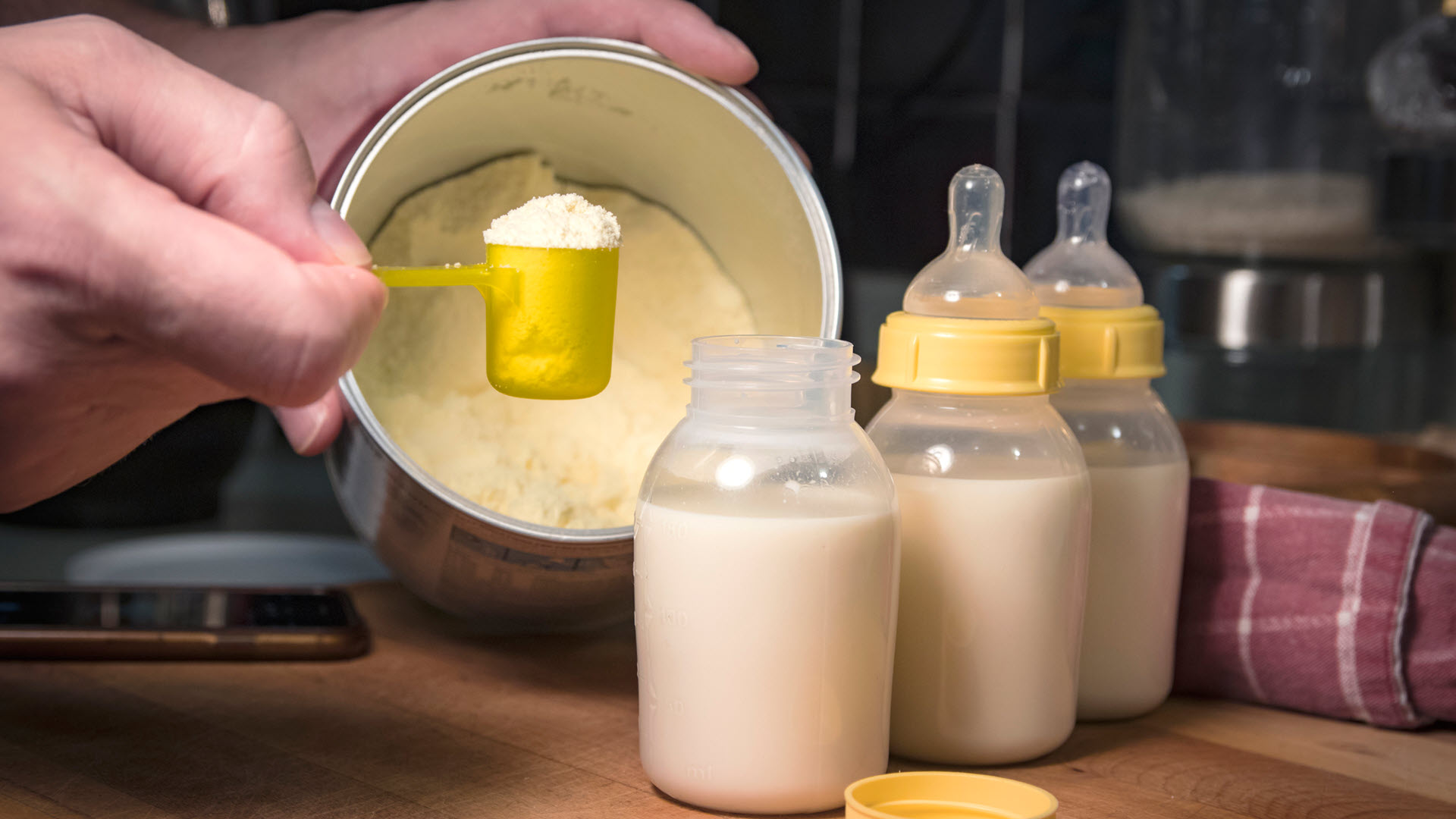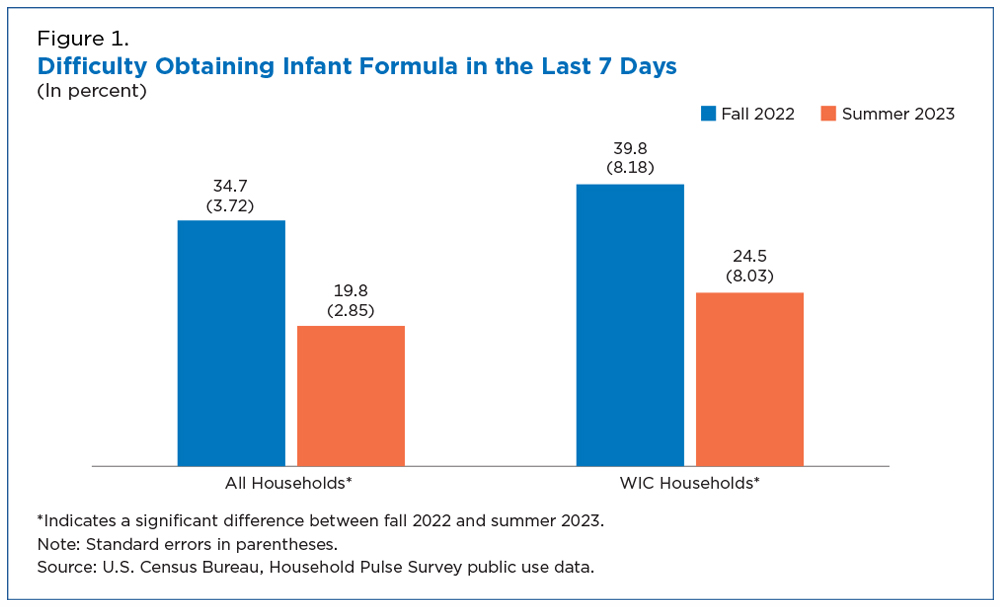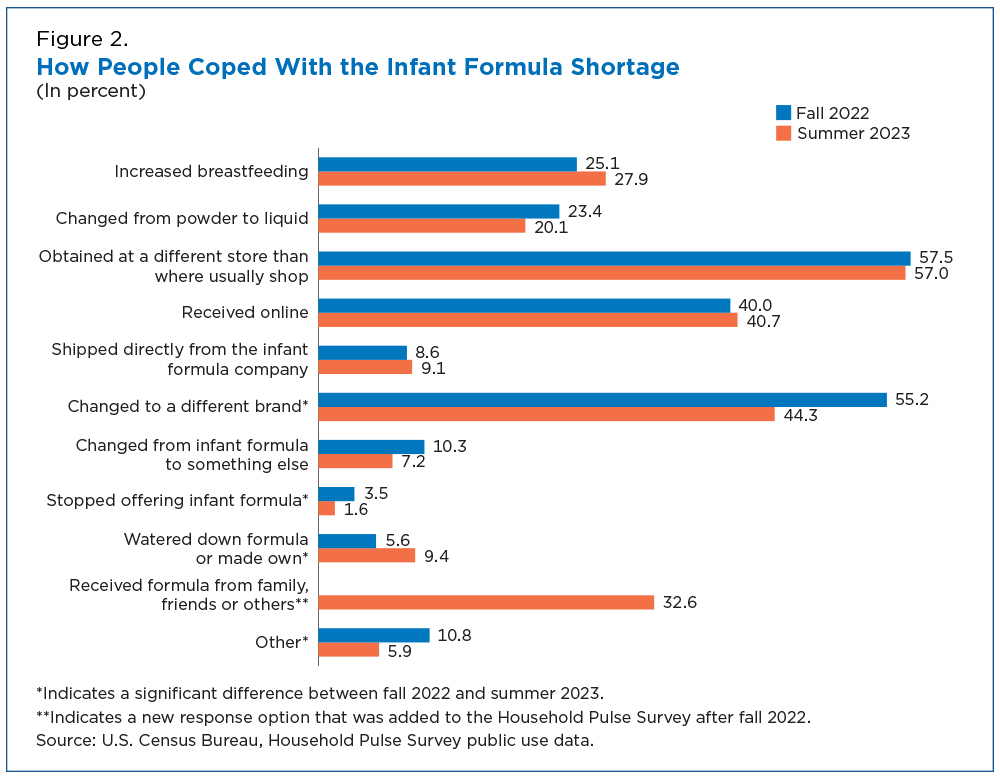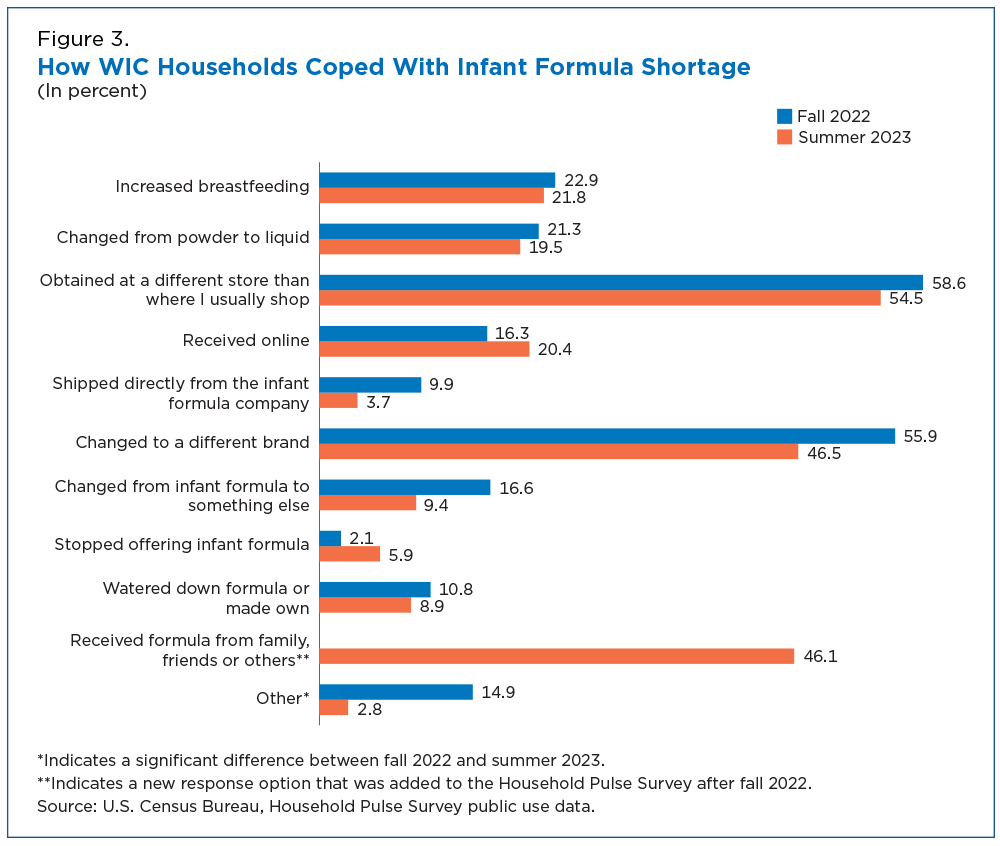About 20% of Parents Reported Difficulty Getting Infant Formula in Summer 2023, Down From 35% in Fall 2022
In 2022, the United States experienced an infant formula shortage [PDF 10.4 MB] due to the COVID-19 pandemic, a large voluntary recall, and related supply chain issues.
Data show that ‘obtained formula at a different store than where they usually shopped’ was parents’ most common way of coping with the formula shortage, with more than half of all households, selecting this option both in fall 2022 (57.5%) and in summer 2023 (57.0%).
By summer 2023, about 20% of parents said they had a hard time finding formula — more than a 14 percentage point drop from fall 2022, according to the experimental Household Pulse Survey (HPS), which has been asking parents if they were having difficulty getting infant formula since September 2022.
Working collaboratively, the Food and Drug Administration, the Food and Nutrition Service, and the U.S. Census Bureau crafted a question series designed to measure the impact of the infant formula shortage. Questions included measures of difficulty for obtaining infant formula and ways parents coped with the shortage.
The HPS is the first data source to offer both a national and state-level look at the impact of COVID-19 on the infant formula shortage. The question series began in September 2022 but was updated [PDF <1.0 MB] in December of that year after testing.
In an analysis of the large, nationally representative sample of U.S. households, we compare survey results from the first measurement of the shortage’s impact in fall 2022 to results in summer 2023.
Difficulty Obtaining Infant Formula
Parents with infants or babies under 1 year were asked whether they had difficulty obtaining infant formula in the last seven days.
In fall 2022, (September 14- October 17), parents in just over 1 in 3 U.S. households (34.7%) reported difficulty obtaining infant formula in the last seven days.
By summer 2023, (June 28-Aug. 7) the number had decreased to 19.8%.
This 14-point drop shows that the shortage had subsided as the pandemic emergency ended and formula became more accessible in stores.
Impact of Infant Formula Shortage on Low-Income Households
In 2021, there were 3.6 million infants in the U.S. and 1.5 million (42%) [PDF <1.0 MB] participated in the Special Supplemental Nutrition Program for Women, Infants, and Children (WIC). When the formula shortage began in 2022, the Food and Nutrition Service issued temporary waivers to expand formula options for WIC participants.
In fall 2022, more than a third (39.8%) of WIC households with infants or babies under 1 reported difficulty obtaining infant formula in the last seven days.
By summer 2023 this number had decreased by over 15 percentage points, with 24.5% of WIC households with infants or babies reporting difficulty obtaining infant formula.
How Parents Coped with the Shortage
Parents who reported being affected by the shortage were asked about behaviors they used to deal with the formula shortage such as changing to a different brand or type of formula or shopping at different stores. Respondents were asked to “select all that apply” among the listed categories.
Percentages are based on the direct selection of each category and do not add to 100 because multiple behaviors could be selected.
Data show that ‘obtained formula at a different store than where they usually shopped’ was parents’ most common way of coping with the formula shortage, with more than half of all households, selecting this option both in fall 2022 (57.5%) and in summer 2023 (57.0%).
Another common method for dealing with the shortages in both time periods included ‘changed to a different brand of formula,’ which decreased by over 10 percentage points, from 55.2% in fall 2022 to 44.3% in summer 2023.
By summer of 2023, HPS had added the new response option: ‘received formula from friends, family, or others’ after questionnaire testing.
Almost a third (32.6%) of households reported this as one major way of dealing with the formula shortage.
Dealing With Formula Shortage Among WIC Households
Two of the most common ways WIC households dealt with the infant formula shortage were by ‘obtaining formula at a different store than where they usually shopped’ and ‘changing to a different brand’.
The number of WIC households to report ‘other’ also decreased considerably, from 14.9% to 2.8%, showing that households were perhaps better represented by the ‘received formula from family, friends, or others’ category added to the survey after fall 2022.
About the Household Pulse Survey
The HPS provides near real-time data on the impact of social and economic factors like employment status, food security, and housing security are affecting Americans’ lives. Information on the methodology and reliability of these estimates can be found in the source and accuracy statements for each data release.
Data users interested in state-level sample sizes, the number of respondents, weighted response rates and occupied housing unit coverage ratios can consult the quality measures file available at the same location.
These data were collected over twelve data weeks from Sept.14, 2022 to Aug. 7, 2023 of the survey, which was sent to more than 1 million adults in households every two weeks.
Related Statistics
Stats for Stories
Stats for Stories
Subscribe
Our email newsletter is sent out on the day we publish a story. Get an alert directly in your inbox to read, share and blog about our newest stories.
Contact our Public Information Office for media inquiries or interviews.









